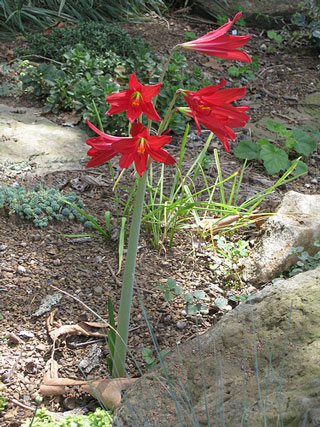Resource Library
Plant of the Week: Lily, Oxblood or Schoolhouse
Oxblood or Schoolhouse Lily
Latin: Rhodophiala bifida
Lily, Oxblood or Schoolhouse -- Oxblood lilies are one of the fall blooming bulbs that I'll try again even though I lost it on the first attempt. (Image courtesy Gerald Klingaman)
Oxblood lilies belong to the amaryllis family and are one of 30 species of bulbous Rhodophiala native to Argentina, Uruguay and Chile. This species has slender black bulbs that pull themselves 8 inches or more deep using contractile roots.
In the fall, usually around the time school reconvenes, it sends up two foot-tall slender scapes bearing four to eight bright red flowers that look like an amaryllis blossom that never quite opens all the way up. The funnel-shaped blooms are about 4 inches long. Individual flowers last for only a couple days in the heat of late summer but blooming clumps remain in flower for about two weeks.
Following flowering, the .5-inch wide foliage to 18 inches long, emerges from the bulbs and persists through the winter when it dies away with the arrival of warm weather in late spring.
Oxblood lilies are native to northern Argentina and Uruguay. They were introduced into the United States almost 150 years ago but remained almost unknown to gardeners outside of central Texas until recent years. A quick check of Dave’s List on the internet shows oxblood lily to be a much loved flower in Texas but even today it seems little grown outside of its introduced homeland. Several factors probably contributed to its relative obscurity.
Peter Henry Oberwetter (d. 1915), a German immigrant who arrived in central Texas sometime before the Civil War, became interested in the rain lilies (Zephranthes) that grew on his farm near Comfort, Texas. He shared bulbs with people around the world, most likely as a native collector/nurseryman. At some point he settled in Austin where, in 1878 he listed himself as a botanist in the city directory. He is buried in an Austin cemetery.
Sometime about 1880, he acquired bulbs of oxblood lilies from a collector in Argentina who probably collected them in the wild in the modern day province of Entre Rios, Argentina. Usually wild-collected bulbs were received in small shipments, so most likely the first thing Oberwetter did was plant them in his nursery rows to see how they would perform and to allow their numbers to increase. No record seems to be available to indicate he distributed oxblood bulbs widely outside of the Hill Country of Texas. During the century following his death, oxblood lilies became a favorite of Texas gardeners, primarily as a pass-along plant.
Oxblood lilies are hardy from zone 7 to zone 11 but do best in locations with hot, relatively dry summers. They grow in full sun or light shade where the flower life is extended if blossoms are protected from the hot afternoon sun. Oxblood bulbs seem equally well suited to acidic or alkaline conditions but should be in well-drained soils. They can be massed in lawn areas, used in the front of informal borders or grown in the rock garden. My bulbs only bloomed two years and then disappeared. I’m not certain if my summertime irrigation did them in or if freezing wintertime weather killed the foliage and starved the bulbs out. A sheltered south-facing location should work better here on the northern limits of their range.
By: Gerald Klingaman, retired
Retired Extension Horticulturist - Ornamentals
Extension News - November 8, 2013
